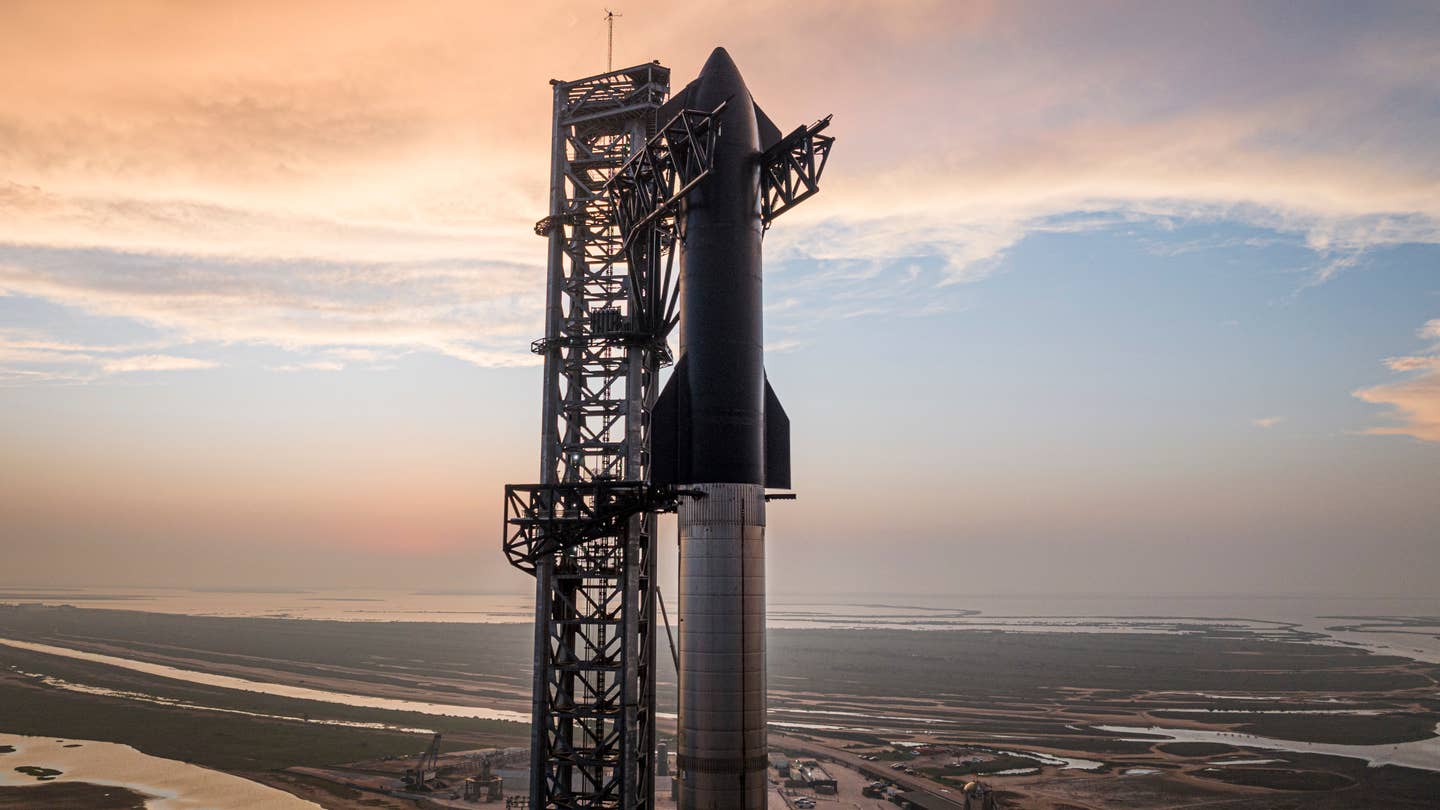SpaceX’s Starship Cleared for Second Takeoff After Obtaining Modified Launch License from FAA
Musk’s previous predictions haven’t come to fruition, but this time, a fresh launch license backs the SpaceX CEO’s timeline.

SpaceX’s Starship upper stage and Super Heavy booster sit stacked on the launch pad ahead of April’s maiden voyage. [Courtesy: SpaceX]
SpaceX CEO Elon Musk has not enjoyed a great track record when it comes to predicting the second orbital test flight of Starship, the largest and most powerful rocket ever built. But Musk’s assertion this week—that the 400-foot-tall Starship upper stage and Super Heavy booster could fly again as soon as Friday—looks like it could come true.
“Was just informed that approval to launch should happen in time for a Friday launch,” Musk wrote in a post on his social media platform X, formerly Twitter.
The SpaceX CEO did not elaborate on who gave him that timeline, and some of his previous predictions have failed to come to fruition. This time, however, Musk’s timeline is backed by the FAA: The agency announced Wednesday afternoon that Starship and the Super Heavy booster are cleared for another takeoff.
"The FAA has given license authorization for the second launch of the SpaceX Starship Super Heavy vehicle," the agency said in a statement viewed by FLYING. "The FAA determined SpaceX met all safety, environmental, policy and financial responsibility requirements."
The regulator said the modified license applies to all phases of SpaceX's proposed operation, from preflight preparation to splashdown, but only for one launch. According to an air traffic control advisory on its website, the launch and reentry mission, “Space X Starship Super Heavy Flt 2,” will take place in Boca Chica, Texas—the site of SpaceX’s Starbase launch pad—on Friday. Backup dates are listed as Saturday and Sunday.
Ready for Launch
On October 31, the FAA confirmed it had completed the safety review portion of its Starship license evaluation. A modified license could not be granted until the evaluation was finished.
The announcement came with the caveat that the agency was still working through an environmental review, which a spokesperson told FLYING is the “last major element” of the process. That step required coordination with the U.S. Fish and Wildlife Service (USFWS) to produce an updated biological assessment of the potential impacts of a Starship launch on the surrounding environment.
Aubry Buzek, who runs public affairs for USFWS's Texas office, confirmed to FLYING that the agency's formal consultation with the FAA concluded on Tuesday, clearing the way for a license modification. On Wednesday, the FAA published a written reevaluation of Starship's environmental assessment, concluding that there are "no significant environmental changes" compared to prior documentation.
According to USFWS, the environmental assessment focused on a new water deluge system that was installed on Starbase to shield the launch pad from the flames of Starship’s 33 Raptor engines. In April, the engines blew a massive crater under the launcher and scattered ash and debris as far as the town of Port Isabel, about 6 miles away.
Starbase did not have such a system for Starship’s inaugural launch, which may have contributed to the damage. Musk said plans to install a water-cooled steel plate beneath the launcher were scrapped because it “wasn’t ready in time,” adding that “we wrongly thought, based on static fire data, that Fondag [concrete] would make it through one launch.”
With a modified launch license in hand, Starship's second test flight could follow in just a few days—the first one came less than a week after the FAA’s initial green light.
As was the case with that launch, the flight will be broadcast live on SpaceX’s website. In addition to the new flame deflector, it will debut a hot-stage separation system and thrust vector control system for the Super Heavy booster engines.
The flight itself is expected to last about 90 minutes, with the Starship upper stage splashing down in the Pacific Ocean off the coast of the Hawaiian island of Kauai.
High Stakes
Plenty is riding on the success of the next Starship launch. NASA picked SpaceX to develop a version of the rocket that will land humans on the moon for the first time in half a century during the Artemis III mission, which is scheduled for 2025. Before then, the company will fly an uncrewed demonstration mission to the moon.
But NASA officials are already "concerned" about the number of test flights Starship must complete even before that demonstration. A top NASA manager said Artemis III will “probably” slip to 2026 as a result.
A delay to Artemis III could throw a wrench into NASA’s other mission timelines. The space agency has already enlisted SpaceX to conduct a second crewed landing demonstration in 2027 as part of the subsequent Artemis IV mission. The goal is to develop a lander “that meets NASA’s sustaining requirements for missions beyond Artemis III,” such as docking with the upcoming Gateway space station and accommodating up to four crew members.
Following Artemis, SpaceX said the ultimate objective for Starship is to ferry hundreds of humans at a time to the moon, Mars, and beyond. Musk himself has claimed the firm will land humans on Mars by 2029. The plan is for the first batch of astronauts to set up a small base, with the aim of one day supporting a colony of 1 million earthlings on the “Red Planet.”
For fans of science fiction, it’s an exciting prospect. To get there, SpaceX will first need to prove Starship can reach orbit without exploding, but the hope is for that litmus test to happen in the next few days.
Like this story? We think you'll also like the Future of FLYING newsletter sent every Thursday afternoon. Sign up now.

Sign-up for newsletters & special offers!
Get the latest FLYING stories & special offers delivered directly to your inbox






